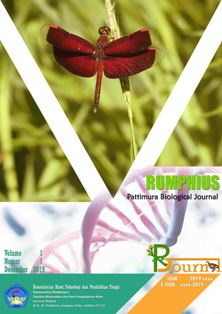RELATIONSHIPS OF FERNS IN THE POLYPODIACEAE FAMILY IN THE BUKIT KUJAU AREA, TEMPUNAK DISTRICT, SINTANG REGENCY, BASED ON MORPHOLOGICAL CHARACTERISTICS
Abstract
Ferns belonging to the Polypodiaceae family are widely distributed across various regions of the world, particularly in forested areas and regions characterized by high humidity levels. The analysis of relationships among ferns can be conducted based on their morphological characteristics. The aim of this study was to determine the relationships among ferns of the Polypodiaceae family in the Bukit Kujau area of Tempunak District, Sintang Regency, utilizing morphological traits. This research was conducted from October to December 2023, during which 35 samples were collected in the Bukit Kujau area through purposive sampling. The relationships were analyzed using the UPGMA method in the NTSys program. The study identified seven species of ferns from the Polypodiaceae family: Platycerium bifurcatum (Cav.), Dynaria querfolia (L.), Davallia denticulatum (Burm.f.), Phymatodes scolopendria (Burm.), Diplazium esculentum (Rezt.), Pyrrosia numularifolia (Sw.), and Drymoglossum piloselloides (Linn.). Based on the grouping analysis, the seven species of ferns exhibited a similarity coefficient ranging from 0.37 to 1.00. At a similarity coefficient of 0.47, the species were grouped into three clusters, each distinguished by morphological characteristics such as sorus shape, sorus type, and sorus color.
Downloads
References
Anggraeni, S. (2005). Study of Species Diversity and Habitat of Ferns (Pteridophyta) in the Customary Forest area of Sanjan Hamlet, Mawang Village, West Kalimantan [thesis]. Pontianak: Tanjungpura University. Faculty of Forestry
Apriyanti, N., Jaya Santri, D., & Madang, K. (2017). Identification of Ferns (Pteridophyta) and their Kinship in the Curup Tenang Bedegung Waterfall Area, Tanjung Agung District, Muara Enim Regency. Journal of Biology Learning, 5(2), 113-116. https://doi.org/Identifikasi Pteridophyta and its Kinship in Curup Tenang Bedegung Waterfall Tourism Area, Tanjung Agung District, Muara Enim Regency.
Cronquist, A. (1982). Basic Botany: Second Endition.New York: Haper and Row Research
Efendi R, Farid BM, Rahim MD, Azrai M, Pabendon M. (2015). Selection of Inbred Maize with Molecular Markers and its Tolerance to Drought and Low Nitrogen. Journal of Agricultural Research. 34:43-53. doi: 10.21082/jpptp.v34n1.2015.p43-53.
Ekoyani, (2007). Species diversity of Terrestrial Ferns in Gunung Bawang Protected Forest Area, Bengkayang Regency. [thesis]. Pontianak: Tanjungpura University. Faculty of Forestry.
Goncalves RF, Silva AMS, Silva AM, Valent A, Ferreres F, Gil-Left A. (2013). Effect of Taro (Colocasia esculenta L. Shott) Planting Conditions on Phenolic Composition and Biological Properties. Food Chemistry. 141(4): 3480-5. doi: 10.1016/j.foodchem PMID:23993510.
Lawrence. G.H.M. (1964). Taxonomy of Vascular Plants. The Mc Millan Company. New York.
Radford, AE 1986. Frundamnetal of Plant Systematic. Harper and Row Publisher Inc. New York.
Rohlf, F.J. (2001). NTSYS-pc: Numerical Taxonomy and Multivariate Analysis System Version 2.1. New York: Exeter Publishing Setauket.
Smith, A.R., Pryer, K.M., Schuettpelz, E., Korall, P., Schneider, H., & Wolf, P.G. (2006). A Classification for Extant Ferns. Journal of Taxon. 55(3): 705-731.
Syufardian. (2003). Analysis of Pteridophyta Diversity in the Protected Forest Area of Mount Biwa, Biwa Village, Nanga Mahap District, Sanggau Regency. [thesis]. Pontianak: Tanjungpura University.
Tjitrosoepomo, G. (2006). General Taxonomy (Basics of Plant Taxonomy). Gadjah Mada University Press. Yogyakarta.
Copyright (c) 2024 Syffa Juniarty

This work is licensed under a Creative Commons Attribution-NonCommercial-ShareAlike 4.0 International License.
Authors who propose a manuscript and have it approved for publication know that the manuscript will be registered and become part of the RPBJ. Authors and readers understand that this journal is open and all its contents can be accessed freely, provided that RPBJ is still listed as the source of information. The hope is that this journal can become a vehicle for exchange and scientific knowledge for society and the scientific community, especially in the field of Biology and other branches of science.









